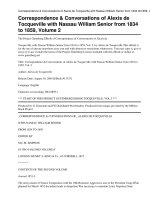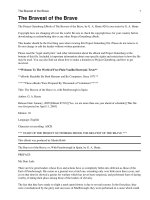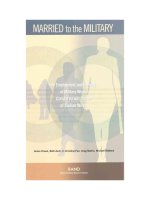UPF of cotton fabrics printed with arecanut slurry
Bạn đang xem bản rút gọn của tài liệu. Xem và tải ngay bản đầy đủ của tài liệu tại đây (216.53 KB, 7 trang )
Int.J.Curr.Microbiol.App.Sci (2019) 8(2): 2258-2264
International Journal of Current Microbiology and Applied Sciences
ISSN: 2319-7706 Volume 8 Number 02 (2019)
Journal homepage:
Original Research Article
/>
UPF of Cotton Fabrics Printed with Arecanut Slurry
Deepa S. Bhairappanavar* and Jyoti V. Vastrad
University of Agricultural Sciences, Dharwad – 580005, Karnataka, India
*Corresponding author
ABSTRACT
Keywords
Cotton, Kokilaksha,
mordant, Thickener,
Sodium alginate,
Blockage
percentage
Article Info
Accepted:
18 January 2019
Available Online:
10 February 2019
The present study was undertaken to investigate the efficiency of natural printed fabric on
UV protection. Arecanut slurry was powdered; sodium alginate and kokilaksha seed gums
were used for the printing process. Optimization of printing recipe was done using 3
different ratios of dye sources with 0.5% combination of sodium alginate and kokilaksha
seed gums. Screen printed samples were assessed for visual acceptance and colourfastness
properties. Samples printed without mordant and with FeSO 4 mordant using 0.5% gum
concentration exhibited higher acceptance (WMS) with respect to depth of colour,
evenness, sharpness and overall appearance. Based on outcome of the study basic portion
and printed portion of cotton fabric were assessed by UPF, UVA, UVB ratings. Samples
printed with pure arecanut slurry exhibited highest blockage (UVA: 99.39, UVB: 99.34)
compared to other samples. Samples printed with 75:25 arecanut:myrobolan combination
exhibited good protection than the 50:50 arecanut:myrobolan printed sample.
Introduction
The sun-blocking properties of a textile are
enhanced when a dye, pigment, delustrant or
ultraviolet absorber finish is present that
absorbs ultraviolet radiation and blocks its
transmission through a fabric to the skin. For
this reason, dyed fabrics provide better sun
protection than bleached fabrics.
Since naturally-coloured cottons contain
pigments that produce shades ranging from
light green to tan and brown, it seemed
reasonable to postulate that they would
provide
better
sun
protection
than
conventional bleached cotton, and that natural
pigments might prove more durable to
laundering and light exposure than dyes, but
there is no published research on the
ultraviolet transmission values for naturally
pigmented cottons (Hustvedt and Crews,
2005).
The purpose of this study was to determine
the ultraviolet protection (UPF) values of
naturally-printed cotton fabric and the effect
of light exposure and laundering on the sunblocking properties of naturally printed
cotton.
The global trends in designer collections are
more and more focused on clothing influence
on human organism. Health hazard caused by
UV radiation, recently increasing, forces
2258
Int.J.Curr.Microbiol.App.Sci (2019) 8(2): 2258-2264
clothing producers to pay attention to giving
their products barrier properties that would
guarantee the protection against this harmful
factor. Fabrics dyed with natural dyeing
plants, in a wide range of colours, healthy for
human organism and protecting against UV
radiation are the requirements of the day
(Przewozna and Zimniewska, 2009). Further
such fabrics are also popular as Ayurvastra
that can fetch utility and functionality in
Naturopathy centres and hospitals as bed
linen, infant wear, and occupational wear.
Arecanut have been identified as a rich source
of flavonols. Seeds of arecanut contain
catechin,tannins (15 %), gallic acid, fat, gum
and alkaloids like arecoline (0.07 %), arecaine
(1 %) (Reena et al., 2009). Amount of
alkaloid present in Arecanut differs depending
on stage of development of the nut. Ecofriendly textile dyeing and printing are new
eye openers among health conscious
consumers. Natural dyeing is one of the ecofriendly technologies in textile colouration
that is gaining more popularity because of the
additional
benefits
of
antimicrobial
performance (Shenai, 2003).
Hygrophila auriculata (L.) belonging to
family Acanthaceae; is also known as
Asteracantha longifolia and commonly
known
as
Neermulli,
Talmakhana,
Kokilakshaand Iksura is a common plant
growing in marshy and water logged areas.
The plant is an important medicinal herb,
widely distributed in India and is used for
different medicinal purposes.
Materials and Methods
Standardization of printing procedure
Desizing of cotton
As the fabric comes from the loom, it has a
mixture of impurities and starches within it.
Desizing is a common pre-treatment process
set to all cellulosic fabrics to eliminate the
starch present in the fabric.
The fabric was treated in 5 gpl detergent
solution with material–to-liquor ratio (MLR)
of 1:40 for 40-45 min to totally wash off the
sizing agents and other impurities. The fabric
was squeezed and rinsed in running water to
make it free from traces of detergent and
dried up.
Pre-treatment agent
In the present study dye powder and
myrobolan powder were combined in 50:50
and 75:25 proportions.
Preparation of dye concentrate
Two per cent arecanut dye powder and
myrobolan was soaked according to ratios of
100:0, 50:50 and 75:25 in a separate bowls for
8 hours in 100 ml water. The solutions were
boiled for 30 minutes. The extracted dye
solutions were made into concentrated forms
by boiling it until the volume of the dye liquor
reduced to 10 ml.
Preparation of mucilage and gum
With water the seeds develop a large amount
of tenacious mucilage (Thankamma, 1999;
Nigam et al., 2015). There is no evidence of
the use of these seeds in printing.Keeping in
vision the above proof the study was taken up
with the following objective assessment of
ultraviolet protection factor of naturally
printed cotton fabrics.
For the present experiment, sodium alginate,
kokilaksha and 1:1 proportion of sodium
alginate and kokilaksha gums were researched
using concentrations: 0.1, 0.2, 0.3, 0.4 and 0.5
per cent respectively. The calculated amount
of gum was directly added to the condensed
dye solution.
2259
Int.J.Curr.Microbiol.App.Sci (2019) 8(2): 2258-2264
Ferrous sulphate mordant was selected for
further printing experiments in the present
study. 0.4 per cent of ferrous sulphate was
mixed in 5 ml water and then added to the
printing paste (10ml).
improves colour fastness properties. After
drying the samples were steamed in 20 litre
cooker. The samples were rolled in cotton
fabric and kept in cooker container and
steamed for 30 min after removal of steam
from cooker samples were removed and dried
for some time
Preparation of printing paste
Visual evaluation of printed samples
Printing recipe
Printed samples were assessed through visual
analysis by thirty respondents using
questionnaire with five point rating scale for
depth of colour, evenness of print, sharpness
of print and overall appearance of the print by
weighted mean score. Based on the outcome
of the survey, 0.5 percent gum concentration
was selected for UPF, UVA and UVB testing
Mordanting
Arecanut:myrobolan ratio - 100:0, 50:50,
75:25
Gum - Combination of sodium alginate and
kokilaksha seed gum
Gum concentration - 0.1 %, 0.2 %, 0.3 %, 0.4
%, and 0.5 %
Washing
Mordant - Ferrous sulphate mordant
According to 100:0, 50:50 and 75:25 ratios,
arecanut dye powder and myrobolan soaked
for 8 hours in 100 ml water. The solutions
were boiled for 30 mins for extraction of dye.
The extracted dye solution was made into
concentrated form by boiling it until the
volume of the dye liquor reduced to 10 ml.
After steaming the printed samples were
given treated with 5 per cent common salt for
30 minutes at room temperature. The fabrics
were rinsed thoroughly in running water to
remove all the vegetative matter deposited on
the print area, rinsed squeezed and dried
under shade.
Ultra-violet protection of natural printed
cotton fabrics
Printing procedure
Once the printing paste was ready, screen
printing process was carried out on cotton
fabrics using screen printing. After printing
the fabrics were shade dried.
After treatments for dye fixation
Steaming and curing
The printed samples are generally steamed.
This process enables the dye molecules to
migrate from the surface of the fibres and
enter the fabric. Steaming swells the fibres
and ensures better penetration of the dye and
UV protection of natural printed fabric was
assessed as per the AATCC-183 (2004) test
method. It measures the transmittance or
blocking of UV radiation through fabrics by
UV-VIS spectrophotometer (varian, cary
5000).
The UV profiles of untreated samples were
compared with the spectra collected from the
same fabrics printed and the effectiveness in
shielding UV radiation was evaluated by
measuring the UV protection, transmission
and reflection. Each measurement is the
average of four scans obtained by rotating the
2260
Int.J.Curr.Microbiol.App.Sci (2019) 8(2): 2258-2264
sample by 90º the transmission data was used
to calculate the UPF, according to the
following equation:
400
E S
UPF =
=280
400
(E S T)
=280
Where E is the relative erythermal spectral
effectiveness; S, the solar spectral irradiance
in Wm-2 nm-1; Tλ, the spectral transmission of
specimen obtained from UV spectro
photometre experiments; and, the band
width in nm (Dubrovski, 2009).
Cotton plain sample and samples printed with
different proportions of dye:myrobolan
printed samples and ferrous sulphate
mordanted samples were subjected to
ultraviolet protection factor at SASMIRA
Mumbai. The results obtained were rated as
per standards and is as below.
Results and Discussion
UPF ratings and protection category
Table 1 revealed that UV protection factor of
natural printed fabric was assessed as per the
AATCC-183 (2004) test method. It measures
the transmittance or blocking of UV radiation
through
fabrics
by
UV-VIS
spectrophotometer (varian, cary 5000).
ASTM D6603-00 Standard Guide for
Labelling of UV-Protective Textiles provides
labelling requirements for textile products
intended to protect human beings from UV-A
and UV-B (ASTM, 2003).
This document contains terminology for
labelling UV-protective textiles. The labelling
categories are “good” for UPF fabric values
of at least 15 to 24, “very good” for UPF
values of 25 to 39, and “excellent” for UPF
values of 40 or higher.
Ultra violet protection of basic portion
(plain) of printed cotton fabrics
Table 2 records the UPF rating and the
blockage percentage of the (plain portion)
natural printed samples. UPF rating of control
sample and without myrobolan were15 each,
UVA blockage and UVB blockage percentage
of basic portions were 94.89 and 93.82.
Sample printed without mordant showed
excellent UPF rating (50) that showed
excellent protection against UV rays; further
UVA and UVB blockage percentage of the
pure arecanut printed sample was 99.39 and
99.34 percent.
A chief constituent of the catechu is catechin
along with small proportions of brown
colouring matter. As the areca catechu
contain many flavonoids having great
antioxidant property. The property of catechin
in human skin is supposed to be the audive
ingredient for the treatment of leukodarma.
Catechin is a biologically important
flovonoids additionally antioxidants from
natural sources are found to be a potential for
the treatment and prevention of UV rays. The
major component from natural sources,
especially flavonoids of plants may have a
potential for the prevention of UV-mediated
diseases such as sunburn and skin cancer
(Anurukorakun, 2016).
Table 2: UPF ratings of printed samples
with 50:50 proportion of arecanut slurry
using sodium alginate andkokilaksha seed
gum
Table 3 exhibited that UPF, UVA and UVB
ratings of basic and printed portion of 50:50
arecanut:myrobolan printed samples. samples
printed with 50:50 arecanut:myrobolan
without mordant was 15 and samples printed
with 50: 50 arecanut: myrobolan with FeSO4
mordant 14 UPF ratings. Similarly UVA
blockage
per
centage
of
50:50
2261
Int.J.Curr.Microbiol.App.Sci (2019) 8(2): 2258-2264
arecanut:myrobolan without mordant was
95.18 percent and sample printed with 50:50
arecanut: myrobolan with mordant recorded
blockage of 95.01 per cent. Feng et al., (2007)
reported that fabrics dyes and printed with
natural dyes had good ultra violet protection.
They could absorb 80-90 per cent of
ultraviolet rays. Vidya and Bhanu (2012)
reported that dyeing bamboo fabrics with
natural colour is increases ultraviolet
protection of fabrics and can be considered as
an effective protection against ultraviolet
rays.
Similarly, UVB blockage of sample printed
with 50:50 arecanut:myrobolan proportion
with sodium alginate and kokilaksha seed
gum without mordant showed 94.11 percent,
sample
printed
with
50:50
arecanut:myrobolan with FeSO4 was 94.24
percent blockage. As a result in the study that
is researched the resistance of the cotton
fabric against the ultraviolet radiation; it is
determined that a prefect protection can be
enabled indoors by using UV absorbent, and
it is seen that the protection increases
depending on the increase of the UV
absorbent material (Merdan et. al., 2015).
UPF of printed samples with 75:25
proportion of arecanut slurry and
myrobolan using sodium alginate and
kokilaksha seed gum
Record presented in Table 4 that UPF, UVA
and UVB ratings of sample printed with 75:25
arecanut:myrobolan ratios. Printed portion of
the cotton sample exhibited higher UPF rating
with 75:25 arecanut:myrobolan proportion
without and with mordant each 26 and 24
ratings. Samples printed with 75:25
arecanut:myrobolan with ferrous sulphate
mordant recorded UPF rating of 21 and UPF
rating for sample oriented with 75:25
arecanut:myrobolan without mordant was 15
that showed good protection from UV rays.
UVA blockage percentage of (plain) 75:25
arecanut:myrobolan samples were 96.55
percent followed by 95.01 percent blockage
of ferrous sulphate mordanted samples.
Further samples printed with 75:25 arecanut:
myrobolan exhibited 97.66 percent blockage
and 97.48 percent blockage for 75:25
arecanut:myrobolan combination of sample.
Table.1 UPF ratings and protection category
UPF range
15 to 24
25 to 39
40 to 50
Protection category
Good protection
Very good protection
Excellent protection
Table.2 UPF of printed samples with arecanut slurry using sodium alginate and kokilaksha seed
gum
Sl.
No
Sample
1
2
Basic portion(Plain)
Printed (without myrobolan)
3
Printed (without myrobolan)
Basic portion (Plain)
UPF rating
UVA blockage
(%)
15
94.89
15
95.34
Printed portion
50
99.39
2262
UVB blockage (%)
93.82
94.37
99.34
Int.J.Curr.Microbiol.App.Sci (2019) 8(2): 2258-2264
Table.3 UPF ratings of printed samples with 50:50 proportion of arecanut slurry using sodium
alginate and kokilaksha seed gum
Sl.No
1
2
3
4
Sample
Printed with 50:50
arecanut:myrobolan
(without mordant)
Printed with 50:50
arecanut:myrobolan
with FeSO4
Sample
Printed with 50:50
arecanut:myrobolan
(without mordant)
Printed with 50:50
arecanut:myrobolan
with FeSO4
Basic portion (Plain)
UPF rating
UVA blockage (%)
15
95.15
14
95.18
Printed portion
UPF rating
UVA blockage (%)
23
97.13
23
96.96
UVB blockage (%)
94.20
94.24
UVB blockage (%)
96.57
96.38
Table.4 UPF of printed samples with 75:25 proportions of arecanut slurry and myrobolan using
sodium alginate and kokilaksha seed gum
Sl.
No
1
2
3
4
Sample
Printed with 75:25
arecanut:myrobolan
(without mordant)
Printed portion 75:25
arecanut:myrobolan
with FeSO4
Sample
Printed with 75:25
arecanut:myrobolan
(without mordant)
Printed portion 75:25
arecanut:myrobolan
with FeSO4
Basic portion (Plain)
UPF rating
UVA blockage (%)
14
95.01
21
96.55
Print portion
UPF rating
UVA blockage (%)
26
97.66
24
97.48
Table 4 showed that UVB blockage
percentage of basic portion of the sample with
75:25 arecanut:myrobolan (ferrous sulphate)
UVB blockage (%)
94.11
96.95
UVB blockage (%)
97.3
97.13
ratio was 96.95 followed by 94.11 percent
blockage in without mordanted sample.
Correspondingly, UVB blockage percentage
2263
Int.J.Curr.Microbiol.App.Sci (2019) 8(2): 2258-2264
of printed sample without myrobolan was
99.34 followed by 96.57 (Printed with 50:50
arecanut:myrobolan with mordant), 97.30
percent for printed with 75.25 A:M ratio
without mordant and 97.13 percent blockage
for samples printed with 75.25 arecanut:
myrobolan ratio with FeSO4 mordant
correspondingly. This may be due to uniform
coating of arecanut dye on the surface of
fabric with 1:1 proportion of sodium alginate
and kokilaksha seed gum. Areca catechu
contains diverse phenolic compounds
including condensed tannins that lead to
diffusion of the dye molecules on the surface
of fabric which inturns gives an additional
coating on plain fabric by even deposition of
the dye molecules (Pawar et al., 2017).
Conclusion
Samples were printed with 0.5% gum
concentration with 100:0, 50:50 and 75:25
arecanut:myrobolan dye proportions. Samples
printed without myrobolan exhibited highest
blockage in without myrobolan oriented
sample (UVA: 99.39, UVB: 99.34) compared
to other samples. Naturally printed samples
with 75:25 arecanut:myrobolan combination
exhibited good protection from UV rays.
References
Anurukvorakun, O., 2016, The involvement
of antioxidant and sun protection
factors. Int. Acad. Conf. Proc, pp.
149-158.
Feng, X. X., Zhang, L. L., Chen, J. Y. and
Zhang, J. C., 2007, New insights into
solar UV-protectives of natural dye. J.
Cleaner Product., 15: pp. 366–372.
Hustvedt G. and Crews P., 2005, The
Ultraviolet Protection Factor of
Naturally-pigmented Cotton. The J.
of Cotton Sci. 9:47–55.
Merdan N., Canbolat S. and Akin F., 2015,
Providing a Protection against
Ultraviolet Lights Indoors via Cotton
Textiles. Marmara J. Pure App. Sci.,
Special Issue-1: 83-86.
Nair, U., Bartsch, H. and Nair, J., 2004, Alert
for an epidemic of oral cancer due to
use of the betal quid substitutes gutkha
and pan masala: a review of agents
and
causative
mechanisms,
Mutagenesis, 19(5): 251-262.
Pawar, S., Sandeep P. and Adivrelaar, R. V.,
2017, Dyeing and polyester nylon
with semi synthetic azo dye by
chemical modification of natural
source arecanut. Natural Prod.
Nioprospect., 8(1): 23-29.
Przewozna, K. S. and Zimniewska, M., 2009,
Natural dyeing plants as a source of
compounds protecting against UV
radiation. Herba polonica, 55(3):
311-318.
Reena, R., Authikat, N. and Michael, A.,
2009, Study on the arecanut for its
antimicrobial
properties.
Pharmacognosy, 1(1): 42-45.
Shenai, V. A., 2003, Technology of printing.
Sevak Publication, Bombay. 1(2): 1050.
Thankamma, A., 1999, Rheumatoid arthritis
and Asteracantha longifolia. Ancient
Sci. Life, 18(3): 1-3.
How to cite this article:
Deepa S. Bhairappanavar and jyoti V. Vastrad. 2019. UPF of Cotton Fabrics Printed with
Arecanut Slurry. Int.J.Curr.Microbiol.App.Sci. 8(02): 2258-2264.
doi: />
2264









